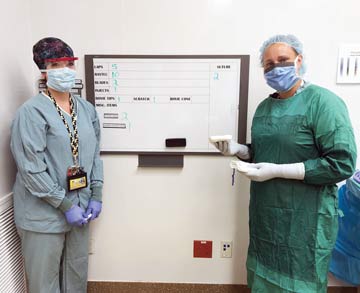April 25, 2024
Growing demand for anesthesia services at ASCs is being met with a dwindling supply of anesthesia providers....
This website uses cookies. to enhance your browsing experience, serve personalized ads or content, and analyze our traffic. By clicking “Accept & Close”, you consent to our use of cookies. Read our Privacy Policy to learn more.
By: Danielle Bouchat-Friedman
Published: 7/14/2020
When the Joint Commission looked at the most commonly reported sentinel events from ambulatory care organizations in 2018 and the first half of 2019, wrong-site surgeries and retained objects topped the list. Never events? Hardly. How should surgical teams respond to the continuing occurrence of avoidable errors? For one, they can prioritize clear communication about safe patient care.
Regularly scheduled pre-op huddles have been paramount in improving the surgical team's communication skills at Boston Children's Hospital, according to Megan Nolan, BSN, RN, CNOR, CSSM, clinical coordinator in the cardiac operating room. An interdisciplinary team meets 30 minutes before patients are wheeled in for surgery.
"We decided to establish a consistent place to meet, and always huddle in the OR so perfusionists and scrub nurses can join the briefing," says Ms. Nolan. "Before we even think about going to get the patient, we go over all aspects of the case. Confirming the patient's weight is a big part of the discussion because it determines the size of the bypass circuit we use and how much blood we give the patient. All of our drug calculations are also based on weight."
Typically, perfusionists set up their pumps the day before a case based on the patient's most current weight, which is noted in the medical records. The nursing staff also has the patient's weight in their records and compares it to the weight recorded in pre-op on the day of surgery. If the updated weight is different than what's been noted in the medical record, even by only 1 kg, a nurse informs the rest of the care team during the regularly scheduled pre-op huddle.
Ms. Nolan recalls a few instances where discrepancies in a patient's weight were caught during the pre-op check and says the briefings have enhanced patient safety. She also acknowledges there's room for improving the process. A scrub nurse, circulating nurse, perfusionist, anesthesia fellow and anesthesia attending are all present during the huddles, but many surgeons have not been able to attend. The scheduled times — 7 a.m. on Mondays, Thursdays and Fridays and 8 a.m. on Tuesdays and Wednesdays — are not ideal for them due to their workflow.

Ms. Nolan hopes this will change in the future because she believes input from every member of the surgical team is essential. "Each discipline focuses on different aspects of patient care and brings different expertise to the table," says Ms. Nolan. "It's sometimes difficult to consider a case from a different viewpoint. Nurses might not see things the same way an anesthesiologist would because they don't have that training."
Transparency among colleagues also remains an issue, according to Ms. Nolan. Some members of the care team have conversations or send emails about the case to individual providers instead of sharing their concerns with the entire team during the pre-op huddle. "We're trying to create a common forum for conversations that typically happen in silos or in microenvironments, so that everybody brings important pieces of information regarding the patient to the table," says Ms. Nolan. "We all benefit when we're on the same page, and when we understand what each person is worried about."
Surgical count boards play a vital role in preventing retained surgical items, but inconsistencies in their design can jeopardize safe patient care. The lack of a standardized counting board was a problem among the surgical facilities of Michigan Medicine, a large health system based in Ann Arbor. Inpatient sites used paper count sheets and ambulatory surgery centers employed whiteboards.
The opening of Michigan Health's Brighton (Mich.) Center for Specialty Care was the prime opportunity for staff at the new facility to develop a standardized count board for the health system's other centers to copy. Perioperative nurses and certified surgical technologists teamed up to modify the inpatient standard count worksheet into a custom dry erase board that would hang in each facility's ORs, says Jillian Bowers, BSN, RN, CNOR, the OR educational nurse coordinator of ambulatory surgery at Michigan Medicine.
She says the creation of a standardized board was a collaborative effort. Staff members were divided into small groups and asked to create their own designs. The teams bounced ideas off each other and then came together as a group to agree on a single template. "Because we involved the staff in the process, we received no pushback," says Ms. Bowers.
The final template included spaces where staff could mark the count of standard items — such as sponges, blades and suture — used during every case. Staff members initially added a space where they could list miscellaneous and specialty-specific supplies such as rubber bands, drill bits and dura hooks. They eventually decided to create magnetic tags that are placed on the board when the items are used.
The boards, which increase the visibility of counts and improve communication and teamwork, were added to the ORs at Michigan Medicine's three other ambulatory surgery centers. Because the boards are hung in spots visible to the entire surgical team, the circulator is able to document each item while maintaining two-person counts.
"The manual counting process in place at our four facilities is truly now a standardized process," says Ms. Bowers. OSM
Growing demand for anesthesia services at ASCs is being met with a dwindling supply of anesthesia providers....
Improvements in both workflow and staff attitudes are part of a leader’s responsibilities, but your interventions in these areas don’t need to be major to make...
The ASC market continues its rapid growth. In 2023, roughly 116 new ASCs opened in the U.S., many of which were orthopedic-specific in nature....